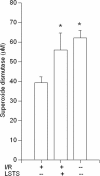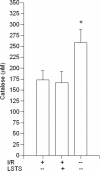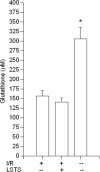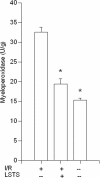Preconditioning somatothermal stimulation on Qimen (LR14) reduces hepatic ischemia/reperfusion injury in rats
- PMID: 24417801
- PMCID: PMC3928919
- DOI: 10.1186/1472-6882-14-18
Preconditioning somatothermal stimulation on Qimen (LR14) reduces hepatic ischemia/reperfusion injury in rats
Abstract
Background: In human beings or animals, ischemia/reperfusion (I/R) injury of the liver may occur in many clinical conditions, such as circulating shock, liver transplantation and surgery and several other pathological conditions. I/R injury has a complex pathophysiology resulting from a number of contributing factors. Therefore, it is difficult to achieve effective treatment or protection by individually targeting the mediators. This study aimed at studying the effects of local somatothermal stimulation preconditioning on the right Qimen (LR14) on hepatic I/R injury in rats.
Methods: Eighteen male Sprague-Dawley rats were randomly divided into three groups. The rats were preconditioned with thermal tolerance study, which included one dose of local somatothermal stimulation (LSTS) on right Qimen (LR14) at an interval of 12 h, followed by hepatic ischemia for 60 min and then reperfusion for 60 min. Serum aspartate aminotransferase (AST) and alanine aminotransferase (ALT) have been used to assess the liver functions, and liver tissues were taken for the measurements such as malondialdehyde (MDA), glutathione (GSH), catalase (CAT), superoxidase dismutase (SOD), and myeloperoxidase (MPO).
Results: The results show that the plasma ALT and AST activities were higher in the I/R group than in the control group. In addition, the plasma ALT and AST activities decreased in the groups that received LSTS. The hepatic SOD levels reduced significantly by I/R injury. Moreover, the hepatic MPO activity significantly increased by I/R injury while it decreased in the groups given LSTS.
Conclusions: Our findings show that LSTS provides a protective effects on the liver from the I/R injury. Therefore, LSTS might offer an easy and inexpensive intervention for patients who have suffered from I/R of the liver especially in the process of hepatotomy and hepatic transplantation.
Figures







Similar articles
-
Preconditioning somatothermal stimulation on right seventh intercostal nerve territory increases hepatic heat shock protein 70 and protects the liver from ischemia-reperfusion injury in rats.J Surg Res. 2001 Aug;99(2):328-34. doi: 10.1006/jsre.2001.6177. J Surg Res. 2001. PMID: 11469906
-
Modulation of liver oxidant-antioxidant system by ischemic preconditioning during ischemia/reperfusion injury in rats.World J Gastroenterol. 2005 Mar 28;11(12):1825-8. doi: 10.3748/wjg.v11.i12.1825. World J Gastroenterol. 2005. PMID: 15793874 Free PMC article.
-
Effects of Wy14643 on hepatic ischemia reperfusion injury in rats.World J Gastroenterol. 2008 Dec 7;14(45):6936-42. doi: 10.3748/wjg.14.6936. World J Gastroenterol. 2008. PMID: 19058328 Free PMC article.
-
Current strategies to minimize hepatic ischemia-reperfusion injury by targeting reactive oxygen species.Transplant Rev (Orlando). 2012 Apr;26(2):103-14. doi: 10.1016/j.trre.2011.10.006. Transplant Rev (Orlando). 2012. PMID: 22459037 Free PMC article. Review.
-
Mild hypothermia pretreatment improves hepatic ischemia-reperfusion injury: A systematic review and meta-analysis of animal experiments.PLoS One. 2024 Jul 2;19(7):e0305213. doi: 10.1371/journal.pone.0305213. eCollection 2024. PLoS One. 2024. PMID: 38954712 Free PMC article.
Cited by
-
Oxidative stress and cardiac dysfunction in children with chronic renal failure on regular hemodialysis.Pediatr Nephrol. 2016 Aug;31(8):1329-39. doi: 10.1007/s00467-016-3314-8. Epub 2016 Mar 18. Pediatr Nephrol. 2016. PMID: 26993814
References
-
- de la Monte SM, Arcidi JM, Moore GW, Hutchins GM. Midzonal necrosis as a pattern of hepatocellular injury after shock. Gastroenterology. 1984;86(4):627–631. - PubMed
-
- Yoshikawa T, Murakami M, Yoshida N, Seto O, Kondo M. Effects of superoxide dismutase and catalase on disseminated intravascular coagulation in rats. Thromb Haemost. 1983;50(4):869–872. - PubMed
Publication types
MeSH terms
Substances
LinkOut - more resources
Full Text Sources
Other Literature Sources
Medical
Research Materials
Miscellaneous

